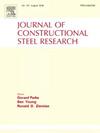Web crippling behaviour of S690 and S960 high-strength steel channel sections under interior-one-flange loading
IF 4
2区 工程技术
Q1 CONSTRUCTION & BUILDING TECHNOLOGY
引用次数: 0
Abstract
The present paper reports experimental and numerical studies on the web crippling behaviour and resistances of press-braked high-strength steel channel sections under interior-one-flange loading. Web crippling tests were conducted on ten specimens, including six for grade S690 high-strength steel and four for grade S960 high-strength steel. The obtained test failure loads, load–web shortening curves, load–web out-of-plane deformation curves and web crippling failure modes were reported. In conjunction with the experimental programme, a numerical modelling programme was performed, where a validation study was conducted to validate finite element models against test results and parametric studies were conducted to generate further numerical data. Based on the test and numerical data, current web crippling design rules for normal-strength steel channel sections under interior-one-flange loading, as specified in EN 1993-1-5, EN 1993-1-3 and AISI S100, were evaluated for the applicability to their high-strength steel counterparts. The evaluation results revealed that the codified design rules provided inaccurate and scattered web crippling resistance predictions. Finally, a slenderness-based design approach was developed and shown to offer a higher level of design accuracy, consistency and reliability for press-braked high-strength steel channel sections under interior-one-flange loading than the existing design standards.
求助全文
约1分钟内获得全文
求助全文
来源期刊

Journal of Constructional Steel Research
工程技术-工程:土木
CiteScore
7.90
自引率
19.50%
发文量
550
审稿时长
46 days
期刊介绍:
The Journal of Constructional Steel Research provides an international forum for the presentation and discussion of the latest developments in structural steel research and their applications. It is aimed not only at researchers but also at those likely to be most affected by research results, i.e. designers and fabricators. Original papers of a high standard dealing with all aspects of steel research including theoretical and experimental research on elements, assemblages, connection and material properties are considered for publication.
 求助内容:
求助内容: 应助结果提醒方式:
应助结果提醒方式:


